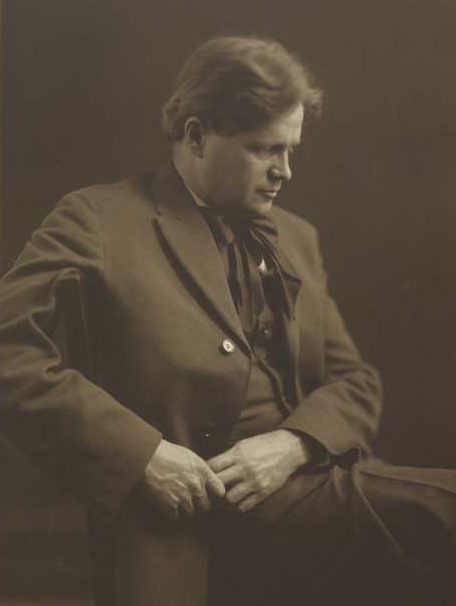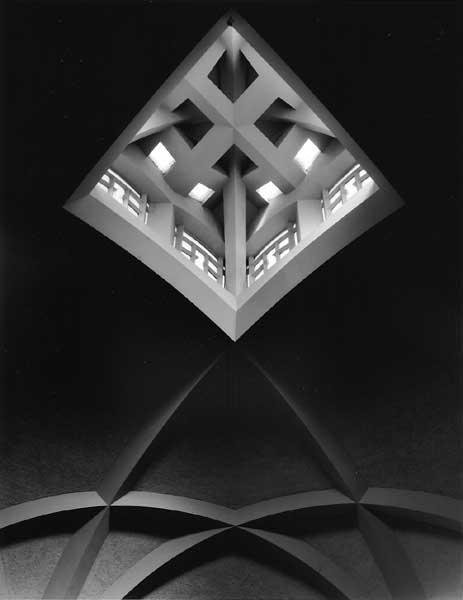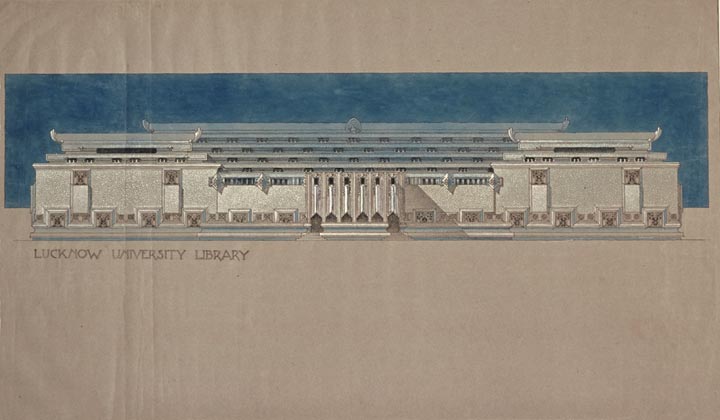Architect, landscape architect, planner
Born: Maywood, Illinois, USA 24 November 1876
Died: Lucknow, India 11 February 1937 Buried at Lucknow, India
Born and raised near Chicago Walter Burley Griffin (1876–1937) was the eldest of four children. He worked as an architect, landscape architect and planner in the United States, Australia and India. His professional career spanned nearly forty years: the early years as a young architect in turn of the century Chicago (1899-1914), the following twenty years in Australia (1914-1935) and the last two years India (1935–1937) before his untimely death in India aged 59.
Walter Burley Griffin was inspired by ideals of equity and democracy and a passionate regard for nature. In 1900, as a recent architectural graduate Walter Burley Griffin, inspired by Louis Sullivan, resolved to create his own kind of modern architecture independent of past styles. When Griffin entered the design field, nature was to be his great source of inspiration. The young architect worked for Frank Lloyd Wright, and we have a sense that his work at that time was suffused with the ‘Spirit of Nature’ in the great tradition of the American transcendentalists, Emerson and Thoreau. This was combined with a search for pure form–a geometric, abstract ideal–inspired by the patterns of nature. This love of nature was evident not only in his and Marion Mahony Griffin’s work, but also in their lives. (Weirick, in a talk to Castlecrag Conservation Society, 30 July 1997.)
United States (1899-1914)
Griffin’s visits as a school student in 1893 to the World Columbian Exposition which became known as the Chicago Fair were inspirational for him, and he was motivated to become a landscape architect. However there was no tuition in this discipline at the time so he studied architecture instead, graduating in 1899 from the University of Illinois. His first job was in the office of architect Dwight Perkins in Steinway Hall, Chicago where some of the most progressive architects also had their offices. For the next two years he worked on a casual basis for a number of the Steinway group, until going to Frank Lloyd Wright’s Oak Park studio where he became an important assistant working there from 1901 to 1905. The working relationship at the Oak Park studio was informal and allowed Walter Griffin to undertake his own personal commissions, the most significant of which was the Emery House at Elmhurst where his handling of form reveals originality and an independence from Wright’s work.
Walter Griffin left Frank Lloyd Wright’s office in late 1905 and set up his own private practice at Steinway Hall. By 1909 he had a wide variety of commissions including over 12 houses, a clubhouse and a library. Stinson Memorial Library at Anna, Illinois convincingly demonstrates his independent interpretation of the Sullivan-Wrightian philosophy. The form and mass of the library are without discernible precedent except for perhaps the Pre-Columbian buildings of the Mayans about which he had a great interest (Harrison, p.22).
When Frank Lloyd Wright closed his studio and went to Europe in September 1909, he left his practice to Hermann Von Holst who promptly engaged architect Marion Mahony to design the more difficult commissions. Walter Griffin was commissioned by them to design a landscape plan for Millikin Place, a proposal with three large houses in a private street in Decatur, Illinois. Every weekend in the summer months from 1909 to 1911, Mahony and Griffin would go on extended canoeing expeditions exploring the streams and rivers of Illinois. On June 29, 1911 they married in Michigan City, Indiana.
In 1911 Walter Griffin had the opportunity to combine his talents as both architect and landscape architect in the one project at Mason City, Iowa. There in an 18 acre site straddling a ravine that included a disused quarry that was conventionally thought of as impracticable for subdivision, Griffin designed a subdivision for 19 houses called Rock Crest–Rock Glen that respected the inherent qualities of the site and restored that natural landscape with extensive revegetation and community reserves. The scheme planned by Walter Griffin was not implemented in its entirety but the Melson House built to his design has been described by Wayne Andrews in 1955 as “one of the irreplaceable houses of the twentieth century” (Harrison, p.23).
Within weeks of their marriage, the Griffins embarked on the design and presentation of their entry for the international competition for the design of the Australia’s federal capital. There were 137 entries from around the world, and the Griffins’ Entry No 29 was announced by the Minister for Home Affairs, King O’Malley on 23 May 1912 as the winner.
By the time Walter and Marion Griffin left Chicago for Australia in 1914 to create the new capital city, he had produced a remarkable body of work of more than 130 designs with about half of them that were realized (Kruty, p.15).
Australia (1914-1935)
In the twenty years they lived in Australia, the Griffins’ remarkable architectural partnership produced over 250 project designs including the capital city, several towns, suburban estates, various civic buildings, a university college, cinemas, theatres, industrial and commercial buildings, domestic houses, furniture and interiors (Turnbull & Navaretti, page xvii).
Walter Griffin was appointed Federal Capital Director of Design and Construction and arrived with Marion Griffin and his relatives, the Lippincotts, in Sydney in May 1914. The federal capital Canberra was to be built on sheep grazing land, approximately halfway between the cities of Sydney and Melbourne. After six years of work, the frustrating obstacles created by bureaucrats and politicians became too great and Walter Griffin was forced to resign from the project on 31 December 1920.
His Canberra contract allowed him to set up independent practice while working on the federal capital. John Burcham Clamp, a leading Sydney architect, had sought out Walter Griffin while he was still in Chicago. After a short partnership with Clamp in Australia, Walter Griffin established his own architectural office in Melbourne, and he and Marion Griffin worked on many commissions including Newman College at the University of Melbourne, the towns of Leeton and Griffith, Café Australia, the Chinese Nationalist Club, the office building Leonard House, the Capitol Theatre and 12-storey office building Capitol House, as well as numerous private houses and several urban town planning schemes including Eaglemont, Croydon and Ranelagh.
When Walter Griffin terminated his work on Canberra, he focused his efforts on creating an urban development in Sydney that would demonstrate how sympathetic planning, and architecture that was subordinate to the landscape, would create an ideal suburb in harmony with its natural landscape. The Greater Sydney Development Association (GSDA) was formed in 1920 and within a few months it bought 650 acres (263 hectares) of land in Middle Harbour that became known as the suburbs of Castlecrag, Middle Cove and Castle Cove.
Castlecrag was developed first. The Griffins moved to Castlecrag from Melbourne in 1925 and lived there for the next ten years. A drafting office was established in one of the Castlecrag houses and later an office was established in Bligh Street in Sydney’s city centre. Griffin designed the narrow roads to follow the contours, all the foreshore land to be a public reserve, for there to be a network of interconnected walkways and reserves for all to enjoy, and for the houses to harmonise with the superb landscape. He designed more than 40 houses for Castlecrag but the Depression and other factors intervened and only 15 houses were built.
Outside of Castlecrag, architectural commissions included private houses for five different clients all in the northern suburbs of Sydney. The Depression made a severe impact on workflow. However an association with Leonard Kanevsky and the Reverberatory Incinerator and Engineering Company (REICo) he established, resulted in a very productive relationship during the Depression years. In 1929 the Griffins formed a partnership with Eric Nicholls, architect in charge of their Melbourne office, to design incinerators for REICo.
This resulted in highly creative and diverse designs that transformed otherwise purely utilitarian function into sculptural elements in their landscapes that were as Griffin put it ‘attractive social conveniences’. Nearly 30 incinerators were designed, 13 of which were constructed, and seven of which survive (two in Sydney, one in Canberra, one in Melbourne, two in South Australia, and one at Ipswich, Queensland).
India (1935-1937)
In the two years Walter Burley Griffin lived in India, part of that time with Marion Mahony Griffin, they designed 95 projects including 53 for the United Provinces exhibition in Lucknow that included a stadium, numerous pavilions, rotundas, arcades and towers.
Walter Griffin departed Australia by ship for India in October 1935 to implement his design for the new library at the University of Lucknow. He planned to stay just three months to complete the drawings for the University library but he was entranced by India, and was inundated with new commissions including Lucknow University Student Union building, a library and museum for the Raja of Mahmudabad, a zenana (women’s quarters) for the Raja of Jahangirabad, Pioneer Press building, municipal offices, many private houses, a memorial to King George V, and all the buildings for the 160 acre United Provinces exhibition which was due to open in December 1936.
Walter Griffin enthusiastically embraced Indian architecture and its decorative elements adapting them and reinterpreting them in self-assured diverse architectural forms as “he sought to create a modern Indian architecture” (Kruty, p.76). “Griffin was able to expand his aesthetic vocabulary to create an exuberant, expressive architecture reflecting both the ‘stamp of the place’ and the ‘spirit of the times’” (Kruty, p.81).
Marion arrived in Lucknow in April 1936 to assist with the workload, and immediately began to train the draftsmen. The magnificent perspectives she drew for the numerous projects reveal her characteristic skill and vigour, capturing Walter Griffin’s Indian designs with great brilliance.
Griffin died on 11 February 1937 in King George’s Hospital, Lucknow, five days after gall bladder surgery. Marion stayed on for a few weeks finishing some of his plans before being persuaded to return to Australia. Walter Griffin is buried in a Christian Cemetery in Lucknow.
Author
Adrienne Kabos is a founding member, past President and currently an active Committee Member of the Walter Burley Griffin Society Inc. She is a Graphic Designer and Coordinator at the Australian National Maritime Museum. Adrienne and her husband John have owned a Griffin home in Castlecrag since 1976.
Further reading
Griffin, Marion Mahony, The Magic of America: Electronic Edition, Art Institute of Chicago, published online only, August 2007, http://www.artic.edu/magicofamerica/
Harrison, Peter, Walter Burley Griffin: landscape architect. Canberra, National Library of Australia, 1995.
Maldre, Mati and Kruty, Paul, Walter Burley Griffin in America. Urbana, University of Illinois Press, 1996.
Turnbull, Jeff and Navaretti, Peter Y (eds), The Griffins in Australia and India: the complete works and projects of Walter Burley Griffin and Marion Mahony Griffin. Melbourne, Miegunyah Press (Melbourne University Press), 1998.
Watson, Anne (ed), Beyond architecture: Marion Mahony and Walter Burley Griffin in America, Australia and India. Sydney, Powerhouse Publishing, 1998.



